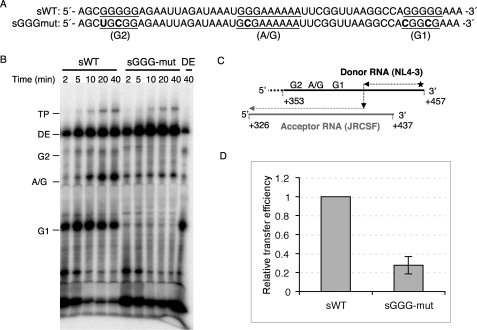FIGURE 4.
Strand transfer assay using short templates that did not include downstream pause sites. A, sequences of sWT and sGGG-mut donor RNAs are shown. Base substitutions made to disrupt the three G or A/G runs (underlined) in the gag hot spot were indicated in bold. B, strand transfer assay of sWT and sGGG-mut templates is shown. Different donor RNAs were indicated on the top of the gel, and the acceptor RNAs used in this assay was sWT acceptor RNA. Reactions were terminated at 2, 5, 10, 20, and 40 min. Donor extension (DE)-sWT donor extension reaction in the absence of acceptor template is shown. This reaction was terminated at 40 min. C, shown is a schematic of the short RNA templates. Bold lines represent the NL4-3 donor RNA (black) and JRCSF acceptor RNA (gray), whereas the hatched line at the 5′-end of the donor RNA represents several nucleotides added to prevent the end transfer. The nucleotides positions in the HIV-1 genomic RNA corresponding to the donor and acceptor RNAs are indicated. Three G or A/G runs are located near the 5′-end of the donor template. D, relative transfer efficiencies of sWT and sGGG-mut templates are shown. DE, donor extension product; TP, transfer product.

